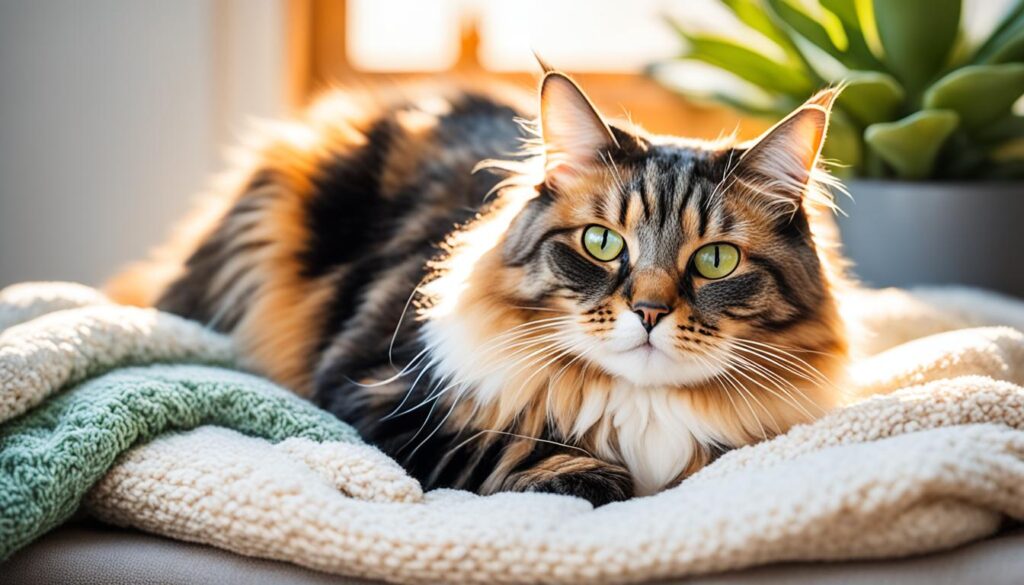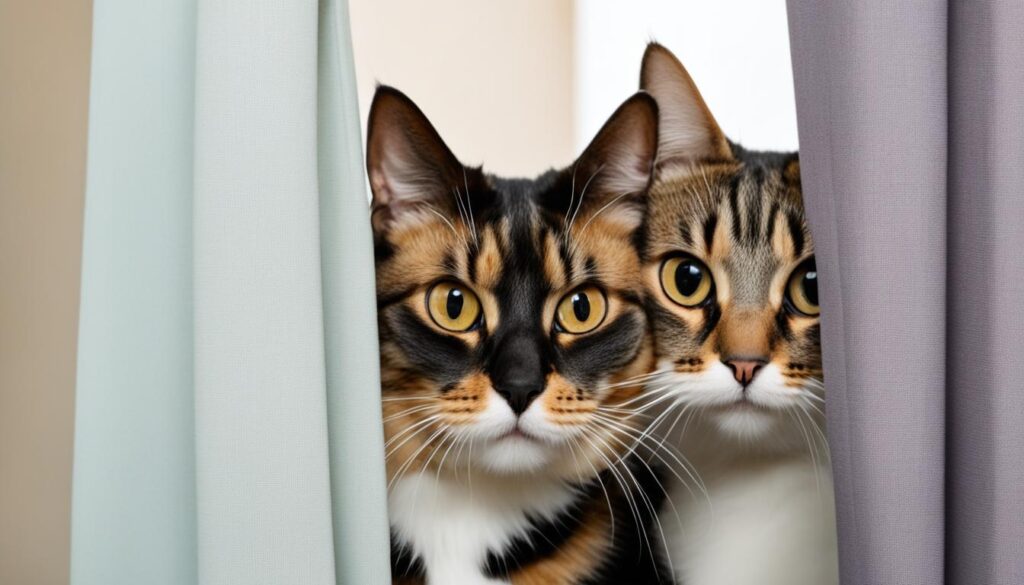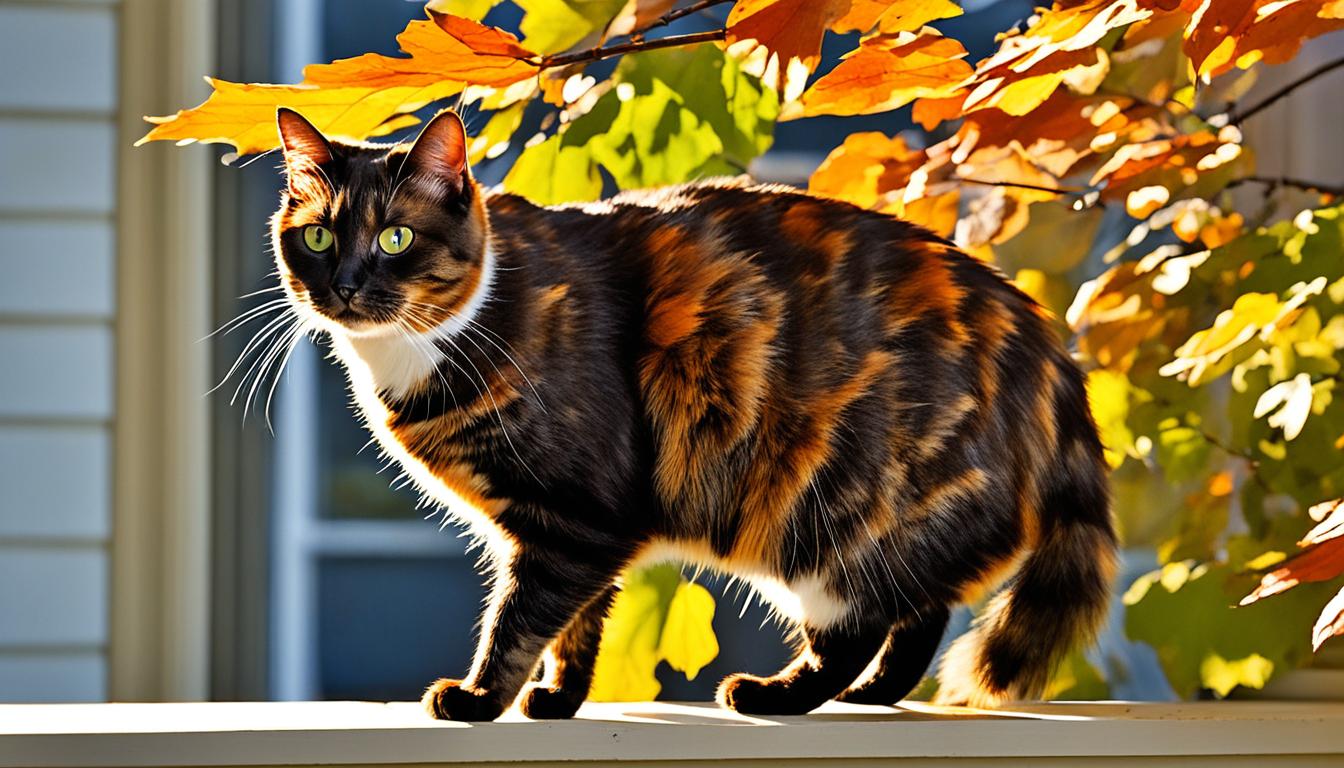Ever wonder why some cats look so unique and pretty? Well, the tortoiseshell cat is one of a kind, with a fur that looks like a mix of autumn’s best colors. But there’s more to these cats than just their looks. They have a lot of interesting traits that make them great pets.
Tortoiseshell cats, lovingly called “torties,” are known for their beautiful coats. These coats have shades of orange, red, chocolate, and white. It’s a mix that’s very rare. Most tortoiseshell cats are actually females.1 Male tortoiseshells are so seldom seen, only about one in every three thousand cats is a male.2
Key Takeaways
- Tortoiseshell cats have a unique and captivating coat pattern, with patches of orange, red, chocolate, and white.
- The majority of tortoiseshell cats are female, and male tortoiseshell cats are extremely rare.
- Tortoiseshell cats are known for their inquisitive and sometimes temperamental “tortitude” personality.
- Proper care, including grooming, dental hygiene, and regular veterinary check-ups, are essential for the health and well-being of tortoiseshell cats.
- Tortoiseshell cats have a long and fascinating history, with folklore suggesting they bring good luck to their owners.
So, what makes tortoiseshell cats so lovable for many cat lovers? This guide will uncover the unique charm of the tortoiseshell cat. It will show why they are perfect pets for anyone looking for an extraordinary and beautiful feline friend.
What is a Tortoiseshell Cat?
Tortoiseshell cats have a stunning coat that makes them stand out. Their coats are a mix of orange, red, chocolate, and white. The patterns can vary a lot, from big color patches to small specks. But, you usually see very little white on a tortoiseshell cat. If there’s mostly white with some red and brown, it’s called a “tortoiseshell and white” or calico in the USA and Canada.
Appearance and Coat Patterns
Their unique coat comes from complex genetics. Tortoiseshell cats’ coats have patches of red, grey, black, and maybe white. Sometimes, you’ll see cream and blue, or lilac and fawn, due to certain genes. This pattern shows up in many cat breeds, but the Japanese Bobtail breed particularly likes it.
Genetic Background
Most tortoiseshell cats are female because of where the pattern genes are. These genes are on the X chromosome. This makes tortoiseshell cats’ colors a mix of their coat genes and how they develop.3
Rarity of Male Tortoiseshells
Male tortoiseshell cats are very rare, making up only about 1 in 3,000 cats. This rarity is because they need two X chromosomes for the special coat pattern. Usually, males have only one X and one Y chromosome. The odd arrangement of their chromosomes also makes male tortoiseshells almost always sterile.34
Personality and Behavior
Tortoiseshell cats have a special trait known as “tortitude”.5 It shows they are curious, do things on their own, and can sometimes be moody.6 These cats are also loving, fun, and a little bit naughty. They mix playfulness, calmness, and warmth.7 Their powerful will and self-assurance can sometimes be tough to deal with. But, they win over their owners with their unique personalities.
The Infamous “Tortitude”
Tortoiseshell cats are famous for having “tortitude”.5 This means they are bold, do things their way, and are quick to voice their feelings.6 Some research shows they might show more tough and fierce actions, like hitting or biting, towards people than other cat types.6 This hot-headed nature is mostly due to their genes, which give them their special colored coats.
Playful and Independent Nature
Besides their “tortitude,”7 tortoiseshell cats are also known for being lively and independent.6 Research suggests they tend to be more on their own and spirited.7 How they act can depend on the type of cat, though. Some might be full of energy and love, while others might keep to themselves more. Anyway, they’re good at letting people know what they want, making them fun and cute friends.
Caring for Your Tortoiseshell Cat
Looking after a tortoiseshell cat is like caring for any other cat. Yet, there are some unique things to keep in mind. Make sure they have fresh, clean water every day. Some tortoiseshell cats might like a water fountain or a raised water bowl.8
Grooming Routine
It’s key to groom your cat often, either at home or by a professional. Grooming helps get rid of loose fur and stops hairballs. Long or short-haired, both types of Tortoiseshell cats need this to keep their coat looking good.8
Litter Box Maintenance
Keeping the litter box clean is a must. A cat’s change in litter box use can signal a health problem. Checking the box and fixing any issues right away is very important.8
Keeping Your Tortoiseshell Cat Safe
Keeping your tortoiseshell cat safe is very important. Always use a cat carrier when you carry your feline. It’s for their safety and sometimes the law8. Also, consider getting your cat microchipped. This helps if they ever get lost. It gives you peace of mind8.
Using a Cat Carrier for Transportation
Using a cat carrier keeps your cat secure. It’s also a legal requirement in many places, preventing car accidents8.
Microchipping Your Cat
Microchipping is a smart move for protecting your cat. It helps if they ever run off8.
Training and Enrichment
If you have a tortoiseshell cat, calico cat, tri-color cat, or any particolored cat, keeping them busy is key. A great start is training them to use a scratching post.9 This way, your furniture stays safe and they get to do what comes naturally. Using a scratching post also helps your tortoiseshell cat keep their claws healthy and sharp.
Teaching Your Cat to Use a Scratching Post
Teaching a tortoiseshell cat, calico cat, tri-color cat, or particolored cat to scratch their post is vital. They’ll learn not to use your furniture for scratching. Remember, patience and positive rewards are crucial for this training. They’ll learn to love their post in no time.
Health Considerations
Keeping your tortoiseshell cat healthy is vital. Make sure she gets regular veterinary check-ups to spot any issues early. This helps in keeping her health in check. It’s a good idea to schedule these check-ups for your tortoiseshell cat.
Dental Care
Don’t forget about dental care for your cat. Lack of dental care leads to tartar and gum problems. Use vet-approved toothpaste to brush your tortoiseshell cat’s teeth. This simple step can avoid many issues.
Spaying or Neutering
If you have a female tortoiseshell cat, consider spaying. For males, neutering is important. This helps reduce the chances of health problems and stops unwanted reproducing.
Tortoiseshell Cat Naming Ideas
Naming your tortoiseshell cat is a fun process. Tortoiseshell cats are usually unique and colorful. Their name should show this, like “Autumn,” “Ember,” or “Calico.”10 You could also pick a name reflecting their personality. For example, “Sassy,” “Spice,” or “Mischief.”11 The key is choosing a name that really fits your tortoiseshell feline friend.
For female torties, there are 220 great names listed.11 Male tortoiseshell cats have 385 names to pick from.11 You’ll also find over 300 cute names for any cat. This includes 135 names for black cats and the top 150 for orange cats.11 What’s more, there are 250 special names for unique cats. These names can be from food items, gems, and even pop culture.
The tortoiseshell cat’s coat stands out with its black, red, and orange patches.10 They are known for being curious and sometimes a bit moody.10 Because of this, there are so many great names to choose from that match their special look and personality.
Creating a Cozy Environment

It’s key to make a cozy spot for your tortoiseshell cat, calico cat, tri-color cat, particolored cat, brindled cat, or piebald cat. This ensures their happiness.12 Most cats like places that are calm, not too busy, and without loud sounds.12 They need somewhere quiet to go when they are stressed.
Choosing Comfortable Cat Furniture
12 Cats look for soft places to sit and sleep. A soft bed or blanket in their own area is perfect. It can be an open bed or one that’s covered. Picking the right cat furniture like soft beds and cat trees will make your tortie happy.
Providing Hiding Spots and Perches
12 Hiding spots make cats feel secure. This could be a cardboard box or a cat tree with cubbies.12 Cats also like to climb. Shelves or tall trees help them feel safe and see their world from above.
12 Keeping pets entertained is vital for their happiness. Toys, scratching posts, and play items are great for fun. They are especially good during noisy activities at home.12 A regular day with set times for eating, playing, and sleeping is very helpful for your cat’s happiness.
12 Make sure the safe area is just for the cat. It’s good to keep other pets and kids away. Teaching kids to respect the cat’s space is important.13 The Sleepypod Mobile Pet Bed is a great option. It gives a cat a cozy spot with soft foam. Plus, its design lets you change it to what your cat likes best.
Feeding Your Tortoiseshell Cat
It’s vital to feed your tortoiseshell cat right for its health. They need a diet that’s balanced and rich in proteins, fats, carbs, vitamins, and minerals. This is the same for pretty much all cats.
Nutritional Requirements
Choose a quality cat food. Pick one recommended by vets for your tortie’s age, how active they are, and any health issues. Talking to your vet helps you find the best diet for your cat.8
Recommended Cat Foods
Tortoiseshell cats need food full of protein, good fats, vitamins, and minerals. Choose cat food made for their life stage, like kitten, adult, or senior. It’s better to give them set meals than to let them eat all day. This keeps them at a good weight and away from health problems.148
| Recommended Nutrients for Tortoiseshell Cats | Optimal Levels |
|---|---|
| Protein | 30-40% of total calories |
| Fat | 20-30% of total calories |
| Carbohydrates | 30-40% of total calories |
| Fiber | 2-5% of total calories |
| Vitamins and Minerals | Balanced levels to meet AAFCO standards |
Introducing a Tortoiseshell Cat to Other Pets

Introducing a tortoiseshell cat to other pets takes time and planning. This is true for any cat with a unique coat like a calico cat or others. You have to be patient whether the cat is new to the house or meeting new pets. Start by making the environment safe and controlled. Proper introductions are key, focusing on scent swapping and letting them see each other slowly.15 Over time, the tortoiseshell cat and the other pets can get along well.
A special cat, Cricket, a tortoiseshell cat, is in a shelter area by herself right now. She’ll mix with other cats only after a special process.15 The owners really want a stress-free home for all their cats, especially for Swanie. They are not rushing into adopting a new cat and have been told to take it slow by their vet.15 Their goal is to show love equally to all their cats, showing how much they care for their pets.15
Swanie was very sad after losing his old friends and acted lonely.15 By slowly introducing Cricket, the tortoiseshell cat, in a calm and loving environment, they hope to create a positive bond. This aims for a happy and friendly atmosphere for all pets in the home.
The History and Folklore of Tortoiseshell Cats
Tortoiseshell cats have a long and fascinating past with stories of luck and mystery. Their colors come from a mix of genes, mostly seen in females.3 They’re linked to good luck in some places, maybe because male tortoiseshells are extremely rare. There’s only one in about every three thousand.1617 Their unique look and stories enchant cat lovers over the centuries.
Tortoiseshell cats are known for their patchy fur, mixing black, red, and more.17 They’re not a breed on their own but are found in breeds like British Shorthair and Persian.17 If you see a tortoiseshell with a tabby pattern, it’s often called a “torbie.”17 In the USA and Canada, three-color cats are called Calico cats.17
Cultures around the world have different beliefs about tortoiseshell cats.17 Some see them as lucky, bringing good vibes.16 In ancient Celtic tales, a male tortoiseshell showing up was a positive sign.17 English stories tell of a wart cure tied to a male tortoiseshell’s tail in May.17
In many Eastern places, tortoiseshell cats are symbolically important.16 Past and present, famous people and even a cat in a station in Japan have owned these cats.17 They thought of them as bringing luck.17
Conclusion
In conclusion, tortoiseshell cats are a special and cherished breed among cat lovers. They are known for their beautiful coats and curious personalities.7 Learning about their needs and interesting facts helps new owners care for them better. And this leads to a more loving home for the cats.
Many are fascinated by the rare male tortoiseshell cats. They appear around once in 3,000 cats7. Others love the stories of luck and wealth these cats bring18. Having a tortoiseshell in your house is incredibly fulfilling. They are known to be strong-willed yet loving and playful.
But it’s important to remember that each tortoiseshell cat is unique. Their colorful coat is just one part of who they are.5 By offering the right care and a happy home, your tortoiseshell will thrive. And they will fill your days with happiness for a long time.
FAQ
What is a tortoiseshell cat?
A tortoiseshell cat has a coat with patches of orange, red, chocolate, and white. They’re known for their unique “tortitude.” This means they can be curious, independent, and sometimes moody.
What is the genetic background of tortoiseshell cats?
Their coat pattern comes from complex genetics. Most tortoiseshell cats are female. It’s very rare to find a male one, happening only once in about 3,000 cats.
What are the key personality traits of tortoiseshell cats?
Tortoiseshell cats have “tortitude.” They’re known for being curious, independent, and at times, moody. They can also be loving, fun, and a bit mischievous.
How should I care for a tortoiseshell cat?
Basic cat care is key, but tortoiseshell cats need some specific things. For instance, make sure they always have fresh water. Also, keep their grooming regular and their litter box clean.
How can I keep my tortoiseshell cat safe?
For safety, always use a cat carrier when you travel with your cat. Also, think about microchipping your cat. It can help you find them if they get lost.
How should I train and provide enrichment for my tortoiseshell cat?
It’s crucial to train them to use a scratching post. This protects your furniture and keeps their claws healthy. Enrichment activities, like puzzle toys, are important too. They keep your cat happy and healthy.
What health considerations should I be aware of for my tortoiseshell cat?
Keep your tortoiseshell cat healthy by visiting the vet regularly. Don’t forget about their dental health and consider spaying or neutering them.
How can I choose the perfect name for my tortoiseshell cat?
Naming your tortoiseshell cat is fun and creative. You can pick a name that shows off their unique looks or quirky personality. Names like “Autumn,” “Ember,” or “Sassy” are great choices.
How can I create a cozy environment for my tortoiseshell cat?
Give your cat soft beds, scratching posts, and cat trees. Also, make sure there are hiding spots and high perches. This helps create a cozy and engaging space for them.
What should I feed my tortoiseshell cat?
Feed your tortoiseshell cat high-quality cat food. Look for a brand recommended by vets. It should include everything they need like protein, fat, carbs, vitamins, and minerals.>p>
How do I introduce a tortoiseshell cat to other pets in the household?
Be patient and plan carefully when introducing them to other pets. Use methods like scent swapping and slow, supervised meetings. This can reduce stress and help the pets get along better.
What is the history and folklore surrounding tortoiseshell cats?
Tortoiseshell cats are rich in history and folklore. Some cultures link them to good luck and wealth because male tortoiseshell cats are rare.
Source Links
- https://www.prettylitter.com/blog/a-fun-guide-to-tortoiseshell-cats
- https://www.holistapet.com/blogs/cat-breeds/tortoiseshell-feline
- https://en.wikipedia.org/wiki/Tortoiseshell_cat
- https://www.cattownoakland.org/cat-town-blog/2021/03/fascinating-facts-about-tortoiseshell-cats
- https://www.catster.com/guides/tortitude-unique-personality-tortoiseshell-cats-fact-fiction/
- https://www.azpetvet.com/understanding-tortoiseshell-cats/
- https://basepaws.com/cat-insider/tortoiseshell-cat-personality-a-quick-walk-through-traits-behaviors-and
- https://www.catster.com/guides/how-to-care-tortoiseshell-cat/
- https://www.catster.com/guides/adventure-torties-take-tortitude-to-the-great-outdoors/
- https://conservationcubclub.com/tortoiseshell-cat-names/
- https://www.dailypaws.com/cats-kittens/cat-names/tortoiseshell-cat-names
- https://ingridking.com/?p=78501
- https://www.worldsbestcatlitter.com/blog/how-to-create-a-cat-friendly-room-in-your-house/
- https://www.catster.com/guides/common-tortoiseshell-cat-health-problems/
- https://thecatsite.com/threads/do-torties-get-along-with-other-cats.289944/
- http://crafty-adventures.blogspot.com/2012/02/legend-of-tortoiseshell-cat.html
- https://www.feliway.co.uk/blogs/news/13-fun-facts-about-tortoiseshell-cats
- https://www.catster.com/guides/tortoiseshell-cat-facts/

